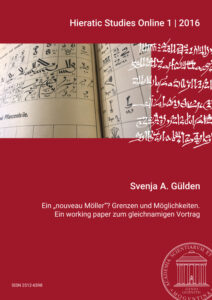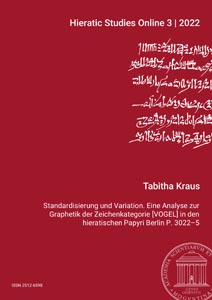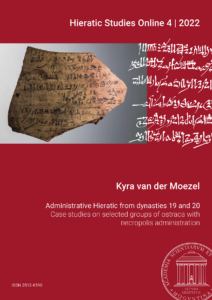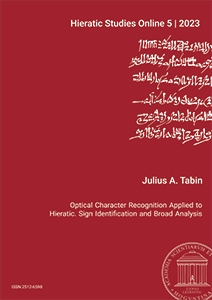The Hieratic Studies Online (HSO) is a double-blind peer reviewed, academic series dedicated to presenting research on all aspects of hieratic and cursive hieroglyphs, for example:
- writing materials and techniques
- the system of the Ancient Egyptian cursive scripts
- development and interconnections between cursive and monumental scripts
- palaeography of signs from single scribes, texts, periods, or regions
- any sources of handwritings and hieratic inscriptions
- text editions
- new readings
- manufacturing of and copying features
- layout, extratextual notes, corrections, additions, marginalia
Open Access
HSO is open-access: All issues can be viewed and downloaded free-of-charge at the Gutenberg Open Science (Open Access Publications) platform. HSO has an open format: Accepted papers will be published as soon as possible. We recommend that you use the CC BY 4.0 license  (if necessary, however, it is possible to use other license formats). There is no defined publication schedule or deadlines. With support of the authors or editors substantial monographs or proceedings may also be integrated in the publication process. HSO offers scholars the opportunity to include a large number of colour images where appropriate to the article.
(if necessary, however, it is possible to use other license formats). There is no defined publication schedule or deadlines. With support of the authors or editors substantial monographs or proceedings may also be integrated in the publication process. HSO offers scholars the opportunity to include a large number of colour images where appropriate to the article.
HSO is edited by Svenja A. Gülden, Tobias Konrad, Kyra van der Moezel and Ursula Verhoeven from the project „Altägyptische Kursivschriften“ at the Mainz academy of Sciences and Literature.
How to submit?
Submissions for HSO can be made both as a Word file as well as a LaTeX file. For detailed information about the submission process see the HSO Guidelines.
HSO Issues
The links below will lead to the Gutenberg Open Science (Open Access Publications) platform where you can download the pdfs of Hieratic Studies Online. Contact: hso@uni-mainz.de
1 | 2016 | Ein „nouveau Möller“? Grenzen und Möglichkeiten. Ein working paper zum gleichnamigen VortragSvenja A. GüldenThough more than 100 years old Möller’s Hieratische Paläographie still is the standard reference work for palaeographic questions. Parts of this palaeography could be complemented and replaced by studies concentrating on specific times spans or sources, but a systematic study of the hieratic script covering all time spans of Egyptian history is– for many reasons – still missing. ‚Ein „nouveau Möller“? Grenzen und Möglichkeiten’ was the title of a paper given at the conference „Ägyptologische ,Binsen‘-Weisheiten“ I, at Mainz in 2011 – this working paper sums up the different aspects discussed in that paper.http://doi.org/10.25358/openscience-811 |
2 | 2021 | Hieratische AktenvermerkeJohannes JünglingAlthough a significant number of the hieratic archival documents bear additional auxiliary signs or sign groups, a systematical study of these hieratic check marks is still missing. The present paper aims to close this gap by providing an overview of the already known hieratic check marks, covering the period between the 5th and 25th dynasties. Those marks are examined with respect to their graphic, phonological, morphological, and semantic features, including a short excursus on hieratic inscriptions on the Amarna tablets. At the end, a table with facsimile samples of the check marks is given.http://doi.org/10.25358/openscience-6202 |
3 | 2022 | Standardisierung und Variation. Eine Analyse zur Graphetik der Zeichenkategorie [VOGEL] in den hieratischen Papyri Berlin P. 3022–5Tabitha KrausThis publication aims to analyse the multitude von bird graphemes existent in the hieratic script. Using four 12th dynasty papyri as source material, these graphemes are described and compared to the underlying birds as well as their corresponding hieroglyphs. Furthermore, the function of the different sign forms of the graphemes and their influence on the reading process will be discussed. Eight basic forms of bird graphemes are determined, which can be recognized as different graphemes using additive elements.http://doi.org/10.25358/openscience-6615 |
4 | 2022 | Administrative Hieratic from dynasties 19 and 20 : case studies on selected groups of ostraca with necropolis administrationKyra van der MoezelThe publication, linked to the data in the online database AKU-PAL, discusses various aspects of ostraca with administrative hieratic script from Ramesside times. The genre of administrative writing is considered and the designation “necropolis journal” is rejected in favor of a more inclusive reference to necropolis administration. The economy of the writing process is analyzed especially in the form of economizing marks and practices of abbreviation. Palaeographic peculiarities in the composition of hieratograms are reviewed as well as text planning and hints at the cognitive writing process. Finally, the handwritings of three scribes are palaeographically reviewed. These aspects are embedded in an overall review of the workflow of scribes in Deir el-Medina during dynasties 19 and 20 and the question how they set up documents and wrote down their administration.http://doi.org/10.25358/openscience-7839 |
5 | 2023 | Optical character recognition applied to hieratic. Sign identification and broad analysisJulius A. TabinDespite modern advances in digital paleographic techniques, hieratic has largely eluded the thorough application of technological methods for automatic sign recognition. To remedy this, this article presents two new hieratic facsimiles (of the Shipwrecked Sailor and part of the Eloquent Peasant), a novel data set of 13,134 individual hieratic signs, and an Optical Character Recognition (OCR) based program developed to analyze them using an Image Deformation Model. This program is highly accurate and various applications are presented, from single character identification to large-scale sign comparisons. This article provides an important building block in the study of hieratic digital paleography, allowing far more signs to be compared at once than ever before, and offers a free, open-source tool and data set.http://doi.org/10.25358/openscience-9590 |